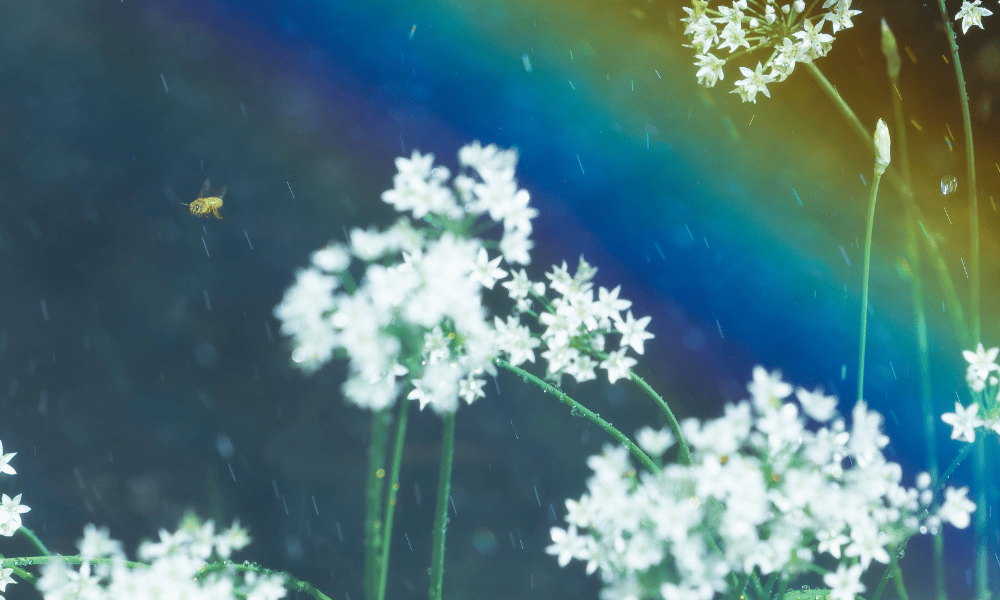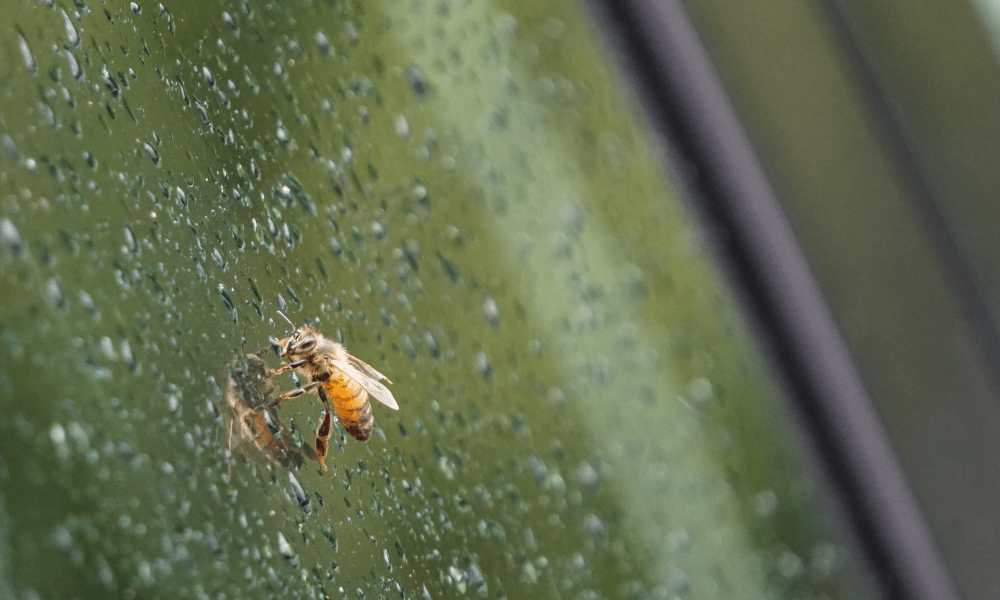When storm clouds gather and the skies open up, you may wonder where the bees go. Rainy days put a damper on lots of summer plans, including the work of honey bees. But, do honey bees go out in the rain or do they have to avoid it?
Honey bees do not go out in the rain. Due to their size, raindrops can knock them out of the air and could throw them into a puddle causing them to drown.
Can Honey Bees Fly in the Rain?
Honey bees could technically fly in the rain but due to the dangers, they tend to find safe places to rest and wait out the rain. Even in the case of a light drizzle or mist, bees prefer not to fly.
The water can stick to the bee, adding weight to their light and perfectly designed bodies. The extra weight causes their wings to have to work extra hard to carry them and sometimes the wings cannot keep up.
Most bees have the ability to fly in the rain but will avoid doing so. It takes a lot of extra energy to fly through rain, energy which a bee would prefer to preserve. Most bees will, therefore, wait out the rain.

Where Do Bees Go When It Rains?
If a bee is at home in its hive when the rain begins, it will stay inside until the rain subsides. However, if a bee is out and about when the rain begins, it will seek shelter and wait out the storm.
Sometimes, you may find bees have made their way into your home or office for protection.
Try to give the bee its space, they are docile creatures and it just wants to go home when it is safe to do so. Once the rain or storm has subsided, the bee will continue its journey home.
Can Honey Bees Drown?
Another reason honey bees do not fly in the rain is that they can easily drown.
Bees cannot swim nor can they hold their breath underwater efficiently. If a large raindrop were to knock a bee into a puddle, the bee would most likely not be able to escape.
Due to the possibility of drowning or getting knocked off course, bees prefer not to fly in rainy or wet conditions.
Want to Attract Bees to Your Garden?
We’ve Put Together a Complete Guide to Attracting Bees to Your Garden Including Our Top 14 Plants You NEED to Have in Your Garden:
How Do Honey Bees Breathe?
Honey bees do not have lungs like humans or other mammals, instead, they have air sacs and tracheas that open to spiracles located around their bodies. The spiracles are holes that are found all over the bee’s body that open and close to allow air into and out of the air sacs.
The air sacs contract and expand to push air in and out, almost like lungs. The air sacs are controlled by the muscles in the abdomen of the bee. When the bee moves these muscles, the air flows.
How Bees Weather a Storm
Bees, like most animals and insects, can tell when a storm is coming. They feel it in an innate and ingrained way. You will notice fewer and fewer bees leaving the hive and if they do they leave, you will see them come back rather quickly and not leave again.
Bees fill holes in their hive with a substance they make called propolis. This substance acts as a glue to reinforce cracks and splits in the beehive. An older beehive will be reinforced well with lots of worker bees repairing it with propolis.
Newer hives will not be as strong and may require extra protection from severe or frequent storms. If the hive is a wild hive, leave it alone. However, if you are a beekeeper, you can put protection over the hive to help prevent water seepage from getting in.
Bees can detect incoming rain so will try to make it back to their hive as quickly as possible. If they cannot get back in time, they will usually take shelter under a leaf in a tree or bush, until the rain has passed.
How Can You Help Bees Weather Storms?
As a beekeeper, protecting your hives is a big responsibility. One way to ensure that your beehive will survive a strong storm is to be sure that the hive is full. If you can, leave honey for the bees during this critical time.
A hive full of honey also ensures that the worker bees can work on securing the hive with propolis instead of making honey for food and storage. The weight of the honey will help prevent the beehive from toppling over or blowing away in extreme winds.
A rainy spring season will also prevent new bees from being born. If the worker bees cannot get out of the hive and get pollen to make honey, the larvae and eggs will not be fed to grow into adulthood.
Keep a check on your bee’s food supply, if you notice it is dwindling, go ahead and feed the bees. Feeding bees in the springtime usually does not disrupt the natural production and population increase in the hive.
Worker bees are very attentive and they will only make enough food for as many bees they have. With a population boom in the spring, bees will easily be able to make up the extra honey with all the fresh flowers needing to be pollinated.
If you are not a beekeeper but want to help bees, you can add a bee hotel or other bee shelter to your garden. This will allow a place for bees to rest and wait out the storms safely.
Summary
Honey bees do not fly in the rain because the large water droplets can actually knock them out of the air and into puddles or other bodies of water leading them to drown. They will take shelter as soon as possible when it begins to rain.







